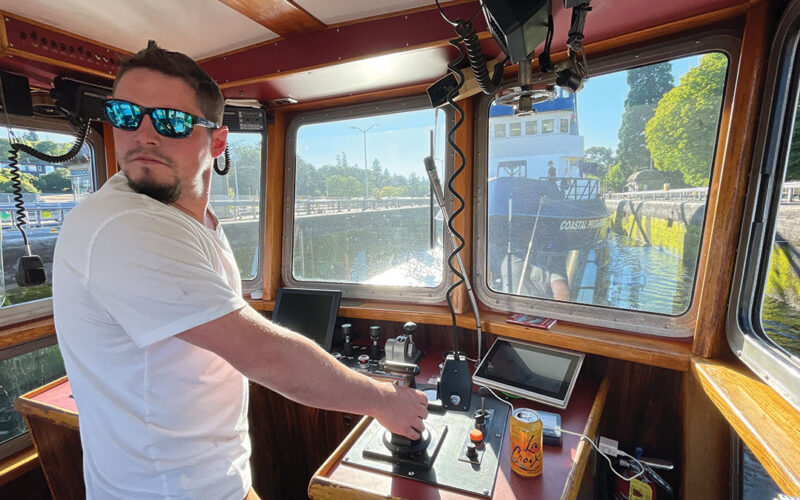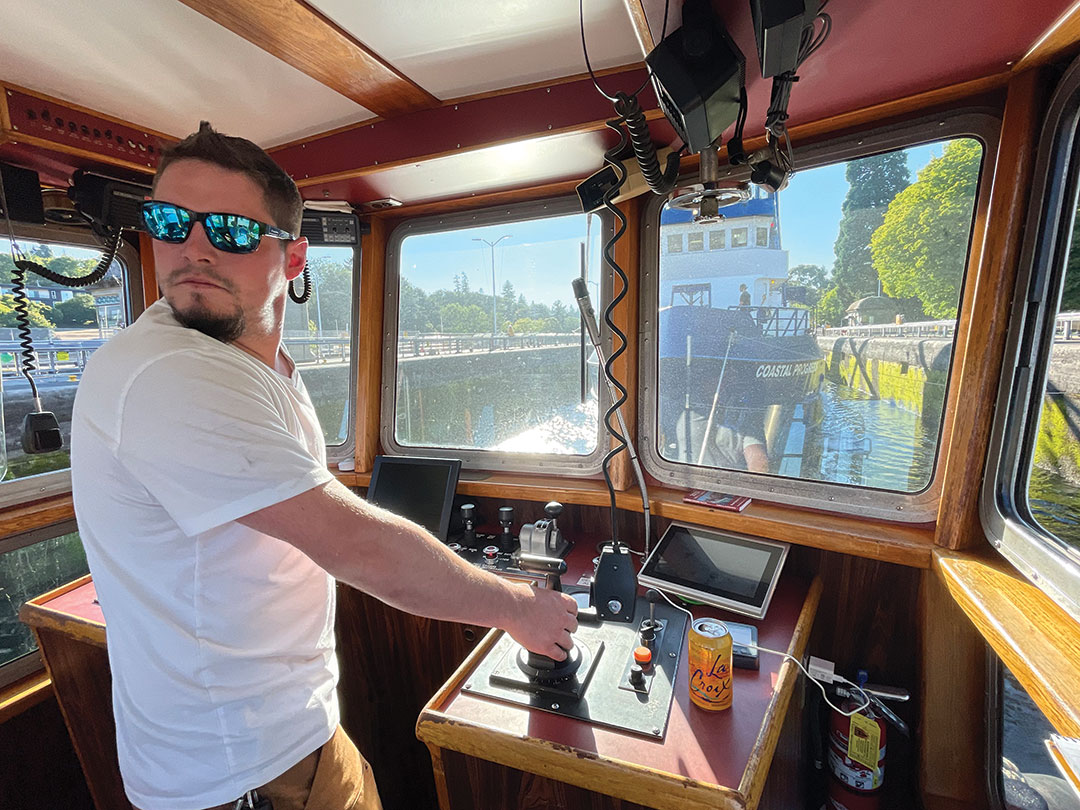
Capt. Travis Larsen looked over his right shoulder and then his left while backing through the crowded waters of Seattle’s Salmon Bay. For nearly 30 minutes, he had steered astern while guiding the 200-foot refrigerated cargo ship Coastal Progress toward the Hiram M. Chittendon, or Ballard, Locks.
Larsen checked his speed and trusted his instincts as the tug controlled Coastal Progress’s bow through the western lock doors. The vessels crept backward at 2 knots until the ship was in position inside the locks.
Only then did Larsen admit this was his first time performing this towing maneuver. Not that anyone could tell.
“I’ve got to tell you, it’s pretty impressive watching you steer backwards,” Coastal Progress captain Dan Liska said over the radio.
“I figured it out,” Larsen responded.
Larsen and deckhand Jaden Brevick got underway about three hours earlier from Western Towboat’s dock along the Lake Washington Ship Canal in Seattle’s Ballard neighborhood. They were headed to Shilshole Bay to assist Coastal Progress to its berth inside the Ballard Locks.
Seattle might be known for rain and gloom, but its summer weather is second to none. Warm weekends bring countless recreational boats and paddlers into the canal, which links the saltwater Puget Sound with freshwater in Lake Union and Lake Washington.
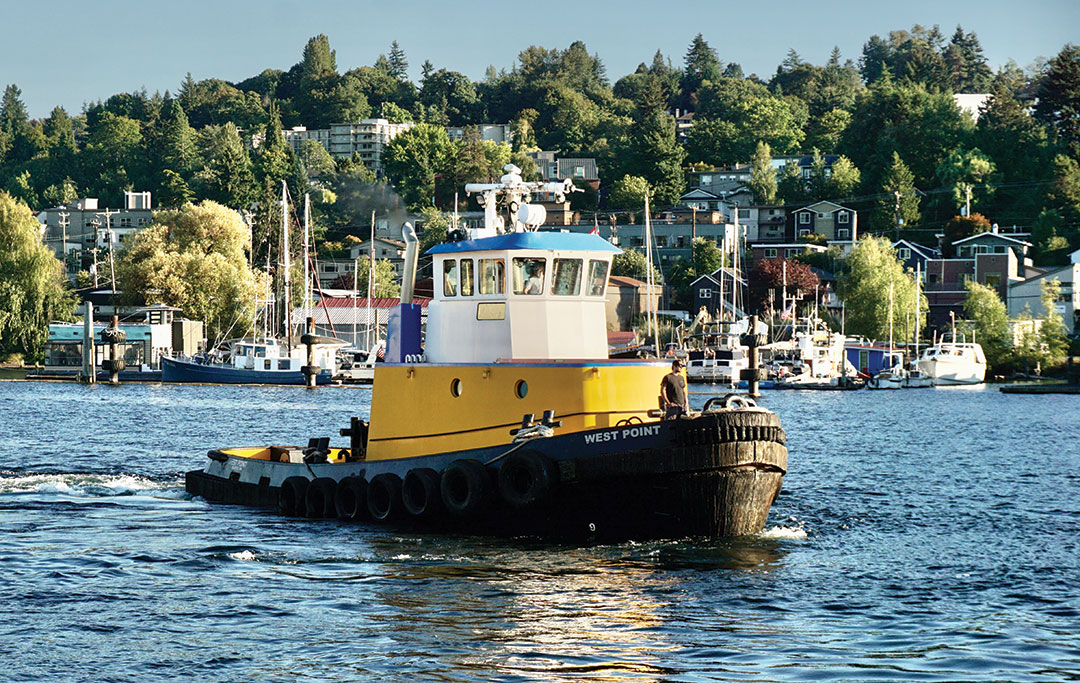
Larsen snaked the 1,200 hp, z-drive West Point to the west, past powerboats boats stacked three- and sometimes four-across the channel, zipping this way and that. Larsen eventually entered the lock chamber and took position on the far west side as eight or 10 powerboats came in behind him.
The water dropped almost imperceptibly at first within the 80-foot by 825-foot chamber. Brevick tended the tug’s lines as a hundred or so tourists watched the locking process. Before long, water within the locks reached equilibrium with Salmon Bay just outside the structure and tug was back underway.
Western Towboat is an institution along the Seattle waterfront. The company, which recently celebrated its 75th year in business, hauls cargo barges to Alaska, assists Coast Guard heavy icebreakers, and does all manner of towing and barge work around the greater Puget Sound area and beyond.
The company builds its tugs at the shipyard along the ship canal. That includes the stout 120-foot Titan-class of oceangoing tugs and its Westrac-class of 80-foot z-drive ship-assist tugs. West Point, at 60 feet-by-25-feet, features the similar lines and z-drive propulsion of its larger Westrac sister tugs. With just a 10-foot depth, it was specifically designed to operate in shallow waters.
“We originally built that tug to work around the lake here and downtown (for jobs) that required a tug that could be a bit shallow-draft but have a higher capability to maneuver fish boats and barges in tight quarters,” said Western Towboat Vice President, Capt. Russ Shrewsbury.
Capt. Ross Shrewsbury, his brother, likened West Point to a “mini-Westrac.”
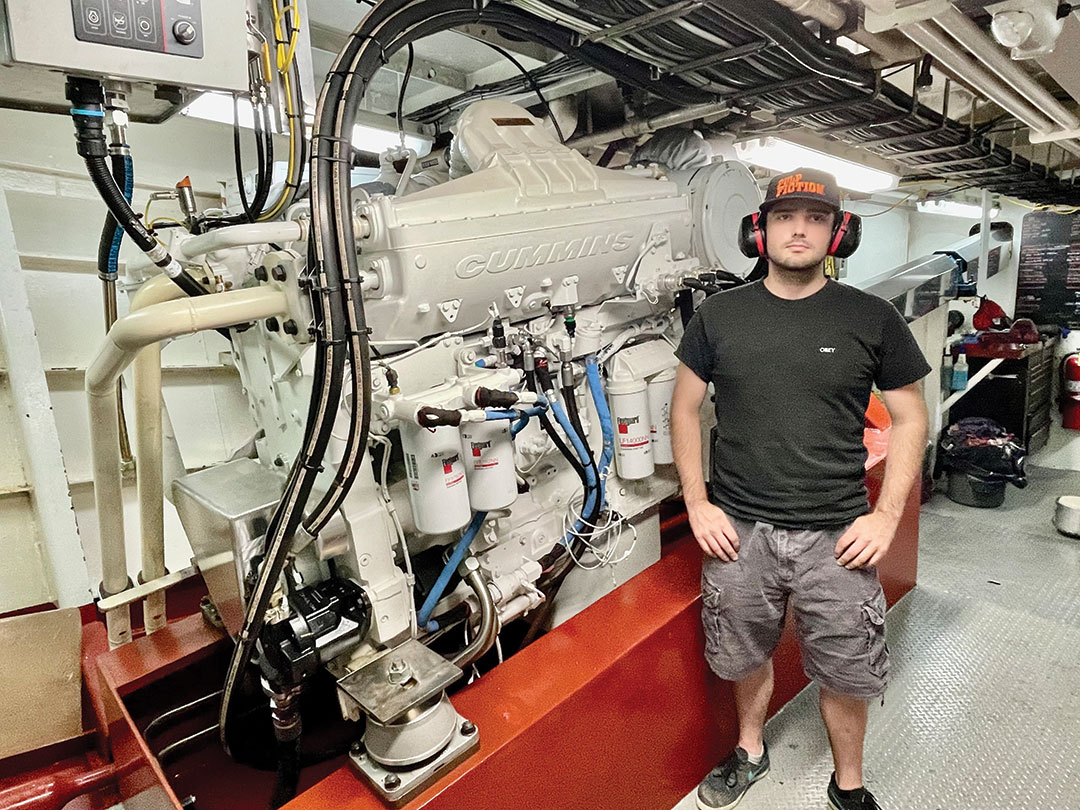
West Point was built in 1992 and Western repowered the tug in 2021 with support from an Environmental Protection Agency clean air grant. They replaced Caterpillar 3412 engines with twin 600-hp Cummins QSK19 mains that met Tier 3 standards. The mains are paired with Ulstein z-drives turning Nautican props in Nautican nozzles. Electrical power comes from a single 75-kW John Deere generator and a shaft-engine mounted emergency genset.
Larsen describes the tug as nimble and powerful, and something of a hot rod. “You pretty much have to drive this thing like you stole it.”
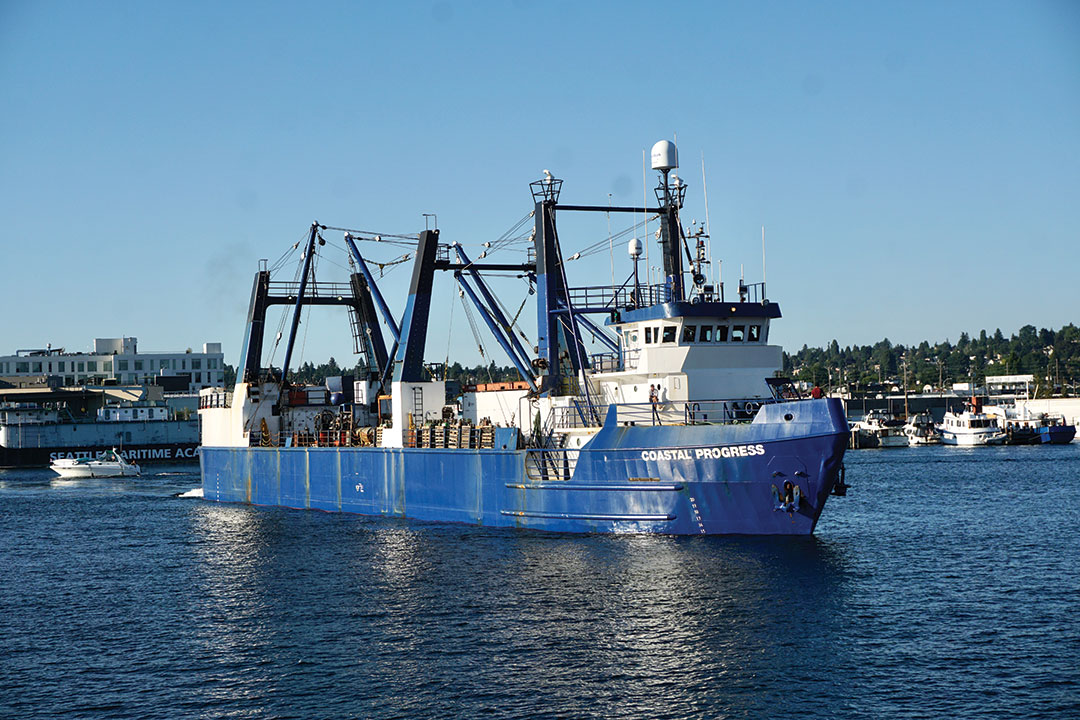
Coastal Progress came into view when West Point entered Shilshole Bay, on the east side of Puget Sound. The freighter returned from a voyage to some of Alaska’s most remote communities carrying refrigerated fish and other cargo. It needed help steering through the locks. West Point’s role was to control its bow during the transit and into the lock chamber.
That maneuver, however, would have to wait. Dozens of powerboats first had to pass through the locks to the east, and once that was complete a similar number would pass through heading west. Coastal Progress and West Point loitered for about 90 minutes in Shilshole Bay in perfect late-summer conditions.

Like many mariners, Larsen’s extended family worked in the trade before him. An uncle works as a Puget Sound pilot. Larsen got his start working as a deckhand for JTC Inc., which was based in Tacoma, Wash. He worked there for five years before joining Western Towboat, where he sailed to Alaska and worked harbor jobs closer to home.
He eventually stepped into a mate’s role and later left to sail as a captain for a marine construction firm in Tacoma. Larsen returned to Western as a captain about a year ago, and since then has learned how to drive tractor tugs. “I am happy to be a floater [captain] and do a little of everything. I like doing all the different jobs. I wouldn’t want to do the same thing all the time,” he said.
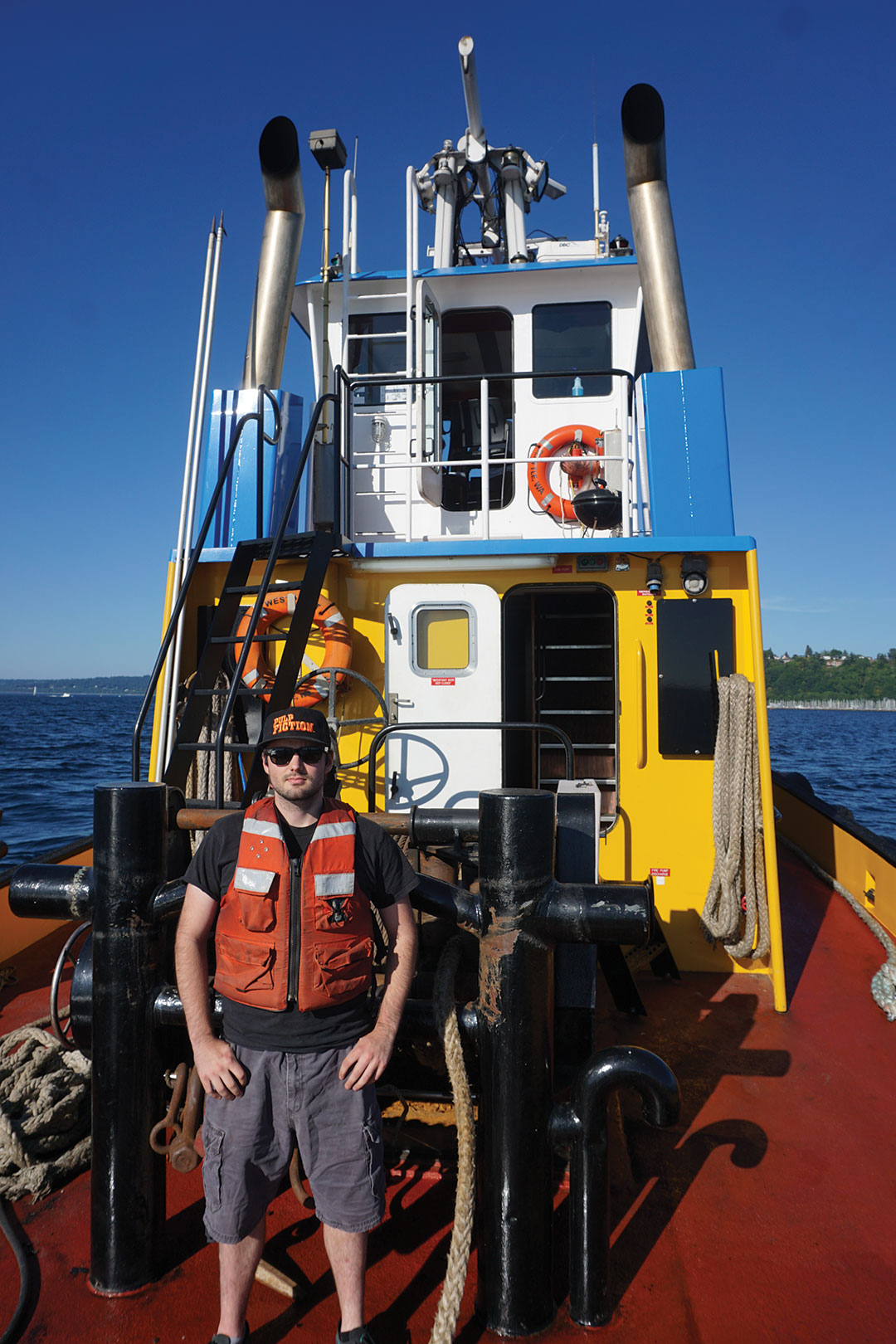
Brevick, meanwhile, joined the company about a year ago after service in the U.S. Navy. He, too, does a little of everything for Western from harbor towing to longer runs to Alaska.
The lockkeeper gave West Point and Coastal Progress regular updates as they loitered in the bay. When the time was right, Brevick got a headline onto the ship and Larsen began backing toward the lock some three miles away.
If nothing else, the towing arrangement was relatively straightforward. Coastal Progress would sail and steer under its own power. West Point, tethered by 75 feet or so of line, would maneuver the bow. The challenge for Larsen, one of them anyway, was to keep a steady speed and a steady tension on the line while steering backward.
Onlookers watched from powerboats, multi-million-dollar homes and seafood shacks as the unusual tow made its way toward the locks. Recreational boats loitered outside the channel as the vessels steered through the Salmon Bay Bridge, which had swung open.
Larsen and Liska stayed in regular radio contact throughout the maneuver.
“I’m all stop right now,” Liska noted as the vessels rounded the final bend toward the locks.
“I’m just pulling easy on 2,” Larsen responded.
The vessels slowed from about 3 knots to 2 as they entered the locks’ western edge. Larsen asked for a heads up before Liska put the engines astern to avoid dragging the ship forward.
The tow entered the lock channel roughly along its centerline, allowing plenty of space on either side. But the final step in the maneuver involved coaxing Coastal Progress toward the northern lock wall. Like the rest of the evolution, the maneuver went smoothly.
“Ok,” Larsen said, “we should be good up here.”
Linesmen secured the ship within the lock, and Larsen relaxed after a challenging bit of towing. The hardest part, he said afterward, was trying to stay in tune with the ship. When it moved, Larsen had to steer accordingly to move with it.
The last leg of the towing job started when the lock doors swung open. Larsen stretched the line and began backing the ship out of the locks. Once free of the lock structure, Liska gave word to haul in the line and stand by while Coastal Progress steered into position at the company dock, just east of the Ballard Bridge.
The vessels sailed east in the ship canal, passing numerous commercial fishing boats of all sizes. Liska hailed the Ballard Bridge, both spans lifted open in plenty of time, and, before long, Coastal Progress was safely in its berth and West Point was free to go.
“Thank you so much, West Point,” Liska said over the radio. “You guys are so awesome to watch. It is impressive what you do.” •

